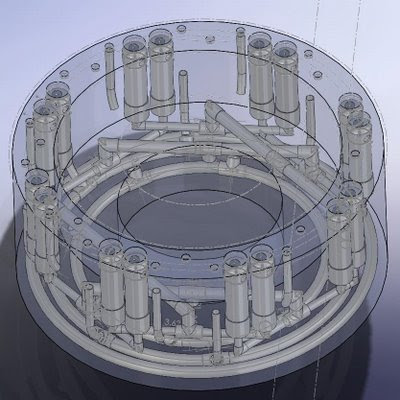"How's the fountain coming?"
"Any news on the fountain?"
"Any progress on the fountain?"
or, from Martha, "Are we ready to can this turkey?" Sometimes at parties!
As a public service, I thought I'd post how things are going.
First, you should understand that the pool will have an 8' diameter round hot tub stuck into the otherwise straight side. 16 streams of water will issue from jets embedded in the wall of that hot tub, and land in a small circle in the center. There is a lot of plumbing to make this work, and here is a partial CAD model of it all:
Each of those fat vertical things is a unit fountain, and each contains a diffuser and a flow straightener, and is topped with a head with a nozzle embedded in it.
I've machined the diffusers, cut some flow straighteners, machined the nozzles and heads, and assembled a single unit fountain. I didn't glue it together. I supplied it with water from a hose.
Here's how I machined the head. I started with a 6" PVC end cap, and milled a flat on the end and two shoulders on either side. These are for aligning the side ports to the nozzle later. You'll see.
Then I put it on a Bridgeport mill. Below, you can see that the quill of the machine has been canted 12 degrees over from vertical. This makes the angle that the water jet will come out on, so that it launches from the wall of the hot tub and lands in the hot tub. You can also see the parallel on the two studs in front, which fits against the shoulder I cut earlier. This edge is parallel to the X axis of the mill. So the mill is canted 12 degrees in the plane of this shoulder, which means I can drill holes in the end cap aligned to this nozzle later.
Here's me working the thing. It turns out that lubricant makes everything a lot easier. The Forstner bit was not the best thing to cut this hole with, as I got a lot of heating and chatter. Occasionally the mill would throw chunks of plastic across the room, so the safety glasses were a must.
I cut the diffuser on a ShopBot at the Sawdust Shop, out of 1/4" PVC sheet. The ShopBot is a CNC router. You program the computer to move the router (they call it a spindle because it goes up to 25000 RPM) in 3 axes. Programming isn't too hard -- you use a ShopBot program to convert line drawings (AutoCAD type, I made them in SolidWorks) into tool paths. We wrote some text programs to step and repeat the pattern once we had it properly tweaked.
The table is covered in chips because we didn't run the vacuum. The owner didn't want to mix PVC chips into his sawdust since he uses the sawdust for something.
Result: just after the hose is turned on, it works great. Flow is smooth almost all the way to the end, certainly good enough to be acceptable. Here it is just after startup. Understand that the unit you are looking at will be one of 16 buried in the wall of the hot tub, and the streams will issue from holes cut into the sides of the tiles that cover the top of that wall. So you won't be looking at ugly PVC.
However, within a matter of seconds, the flow becomes less smooth, breaks up, and soon I have a gloppy mess at the impact point.
Another (minor) problem: I've got a small leak between the nozzle and the endcap, right where the shoulder is thinnest because I've got the flat spot. This is eventually going to be buried in concrete, which will greatly slow the already trivial leakage, but I'm not thrilled about this either. This problem I probably won't fix.
My guess is that I'm getting variations in the flow rate. The fountain is extremely sensitive to these variations -- a 1% change in flow (from 193 to 194.98 gallons/minute) makes a 2.1% change in vertical height and a 2.0% change in horizontal throw. 2% doesn't seem like so much but it's over an inch, for a stream which is around a half-inch in diameter. I think the variations I was seeing were at least an inch of throw, at frequencies from 3 to 10 hertz.
There are two possible reasons I wasn't seeing the variations at first:
- Because the hose wasn't fully up to pressure. The hose is not linearly elastic. When I first turn the water on, the hose fills with water, but it doesn't develop any pressure until it sees back pressure from the nozzle. At partial flow through the nozzle, the back pressure is low enough that the hose is quite stretchy, and so it acts as a surge tank and filters flow variations. At full back-pressure (probably just 2-3 psi), the hose has developed it's fully round shape and is considerably stiffer, losing the filter function.
- If there is air in the fountain, it will act as a surge filter. If I could figure out a way to insert a tennis-ball-sized flaccid bladder filled with air into the fountain, I'd probably have this problem licked, but I'd need something guaranteed not to leak in 30 years immersion. I don't know what that is.
Obviously I need to figure out exactly what is going on, and how to fix it. I'll post some analysis later.











You might want to try a water heater expansion tank for your line surge filter.
ReplyDeletehttp://www.google.com/products?q=water+heater+expansion+tank&oe=utf-8&rlz=1R1GGGL_en___US309&client=firefox-a&um=1&ie=UTF-8&sa=X&oi=product_result_group&resnum=1&ct=title
These are designed to last a long time. I'd put an orifice upstream of the expansion tank to make an RC filter. A ladder of orifices and expansion tanks may give you an arbitrarily smooth pressure supply.
Chris
cool!
ReplyDelete